Yeah, Like You Wouldn't Bust Caps at Hitler's Benz
 Many months ago (actually just a few), when Boog and I were out for a walk in the Monts d'Or, I spotted and photographed a mysterious castle-looking building on the other side of the Saone River. I wondered idly what it was.
Many months ago (actually just a few), when Boog and I were out for a walk in the Monts d'Or, I spotted and photographed a mysterious castle-looking building on the other side of the Saone River. I wondered idly what it was.As it turns out, this was indeed the Chateau Malartre, built in the 16th century, partially destroyed by fire, seized and sold during the Revolution, etc., as happened with many French chateaus. This one, though, was bought in the 50s to serve as a museum for its new owner's substantial historic automobile collection, which had somehow avoided seizure by the Nazis during the occupation (M. Malarte himself survived deportation). The collection expanded after Malartre's death and the museum's subsequent purchase by the city of Lyon, and it is now considered one of the foremost auto museums in France.
And just a 20-minute bus ride from our place! Grab your fruit snacks, Boog, let's go!
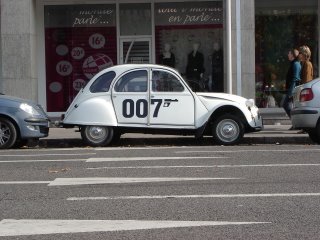 We saw this 2CV right across from where we were waiting for the bus. I'm not sure if the 007 graphic is meant to be ironic or if it refers to the scene in The Spy Who Loved Me where Roger Moore and Melina Havelock flee Fiat-driving baddies down a Greek hillside in a 2CV.
We saw this 2CV right across from where we were waiting for the bus. I'm not sure if the 007 graphic is meant to be ironic or if it refers to the scene in The Spy Who Loved Me where Roger Moore and Melina Havelock flee Fiat-driving baddies down a Greek hillside in a 2CV. Although I consider myself to be somewhat of a car buff, I confess that my knowledge of very early automobiles is pretty lacking. Which is a shame, because this place has a spectacular collection of pre-WWI automobiles. The way they are displayed, too, is remarkable (and very different from US museums) in that you could just walk right up to them and stick your head in.
Although I consider myself to be somewhat of a car buff, I confess that my knowledge of very early automobiles is pretty lacking. Which is a shame, because this place has a spectacular collection of pre-WWI automobiles. The way they are displayed, too, is remarkable (and very different from US museums) in that you could just walk right up to them and stick your head in.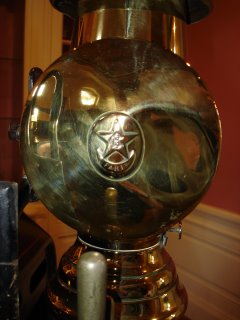 Or take extreme close-up photos of headlamps that were actually, you know, lamps. The handbuilt nature of the early days of automobiles really comes through when you look closely at them. Most of these early cars were assembled piece by piece in converted barns and warehouses, back before the advent of the assembly line.
Or take extreme close-up photos of headlamps that were actually, you know, lamps. The handbuilt nature of the early days of automobiles really comes through when you look closely at them. Most of these early cars were assembled piece by piece in converted barns and warehouses, back before the advent of the assembly line. Lyon was something of a hotbed for this type of cottage industry back in the day. The museum had a nifty illuminated map that would display, at the touch of a labelled button, the location of each the 60-odd shops in Lyon that manufactured running boards or bodies or transmissions or entire cars. Maps that light up tiny lights at the push of a button are museum gold.
Lyon was something of a hotbed for this type of cottage industry back in the day. The museum had a nifty illuminated map that would display, at the touch of a labelled button, the location of each the 60-odd shops in Lyon that manufactured running boards or bodies or transmissions or entire cars. Maps that light up tiny lights at the push of a button are museum gold. The top floor of the chateau is dedicated entirely to vintage motorcycles. I don't know anything about bikes, either, but there was some pretty neat stuff here, too.
The top floor of the chateau is dedicated entirely to vintage motorcycles. I don't know anything about bikes, either, but there was some pretty neat stuff here, too.Too bad the way this pinup girl--strongly reminiscent of WWII bomber nose art-has peeled off this gas tank.
I'm not sure I understand the significance of the fish at the end of the fork.
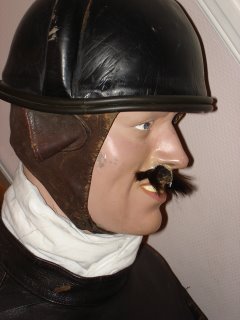
I'd like to believe that early bikers actually wore mustaches like this.

This handsome sage-green roadster's body is entirely covered in custom-fitted, hand-stiched leather. Practical? Oh heck no. Dang, I got caught in a light summer shower and now the car's ruined! It really speaks of a time when cars were purely toys, something for the wealthy to mess about with at the country estate. Sure looks good, though. Check the way the upholstery echoes the engine compartment vents. And I bet it smelled nice when the engine warmed up the leather.
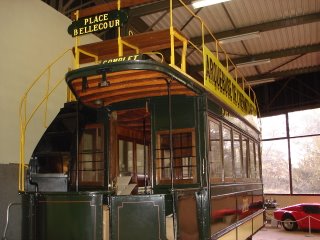 At the other end of the complex, a much more spacious modern building (or hangar might be a better word for it) houses the post-WWI collection.
At the other end of the complex, a much more spacious modern building (or hangar might be a better word for it) houses the post-WWI collection.Boog dug the streetcars and funiculairs displayed there--this one served our street, once upon a time, between Place Bellecour and the Hotel de Ville (City Hall).
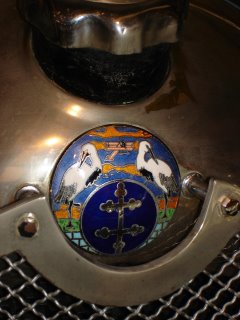
A lot of the pictures I took that day are of hood ornaments and emblems. How does one represent the essential qualities of one's business in a few inches of steel or inlaid porcelain?
This one's from a Lorraine, obviously. But check it out: Besides the Lorraine cross, there are two cranes, a biplane, a brick wall, and a lurid blue-orange sunset.
I think my Boy Scout council patch looked something like this.
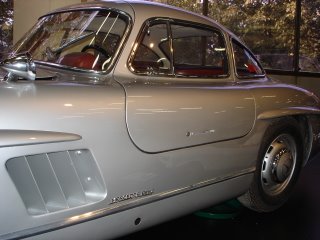 I know I'm far from the first person ever to notice this or mention it, but...
I know I'm far from the first person ever to notice this or mention it, but...Dang, that gull-wing Mercedes 300SL is a good-looking piece of machinery.
First production car to have fuel injection, too. I did not know that.
 I should have taken better notes while I was snapping photos--I don't even remember what this is. I think I just took the picture because I liked the radiator grille. It reminds me of an electric space heater I found in the basement at Mallette Street one time--it would get really hot for about 30 seconds or so, then blam! all the fuses in the house would blow.
I should have taken better notes while I was snapping photos--I don't even remember what this is. I think I just took the picture because I liked the radiator grille. It reminds me of an electric space heater I found in the basement at Mallette Street one time--it would get really hot for about 30 seconds or so, then blam! all the fuses in the house would blow.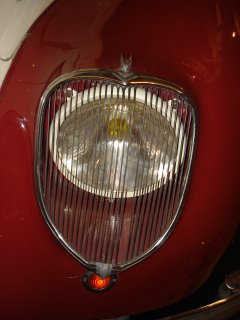 Don't remember what car this was from, either. I suspect something Italian. But I kinda wish car manufacturers would still make vertical-strake headlight cover grilles.
Don't remember what car this was from, either. I suspect something Italian. But I kinda wish car manufacturers would still make vertical-strake headlight cover grilles. Besides the rare and historic cars, the museum also has a sizable collection of cars that belonged to famous personages. They even have a Popemobile left over from the Pope's 1984 visit to Lyon--it's basically just a stretch Renault Espace minivan with only one seat in the back, plus some nice wine-red interior carpeting.
Besides the rare and historic cars, the museum also has a sizable collection of cars that belonged to famous personages. They even have a Popemobile left over from the Pope's 1984 visit to Lyon--it's basically just a stretch Renault Espace minivan with only one seat in the back, plus some nice wine-red interior carpeting.This is Edith Piaf's '55 Packard Caribbean convertible: Low miles, lady driver, all options, new whitewalls.
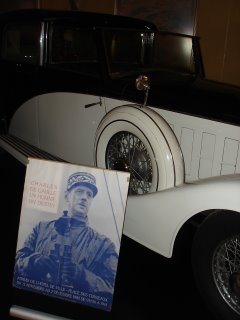 Further along is the Hispano-Suiza used by Charles DeGaulle at the liberation of Paris.
Further along is the Hispano-Suiza used by Charles DeGaulle at the liberation of Paris.Nice ride. But I gotta wonder why ol' Chuck D was rolling in a (neutral) Swiss-designed, (neutral) Spanish-built hooptie. Maybe the Renault and Citroen factories were busy cranking out Panzers and Nebelwerfers. And maybe he couldn't find a Lorraine that was actually in working order.
Down at the end of the display hall is one of the crown jewels in the museum's collection: The Mercedes-Benz parade limousine used by Adolf Hitler himself, and captured by Free French forces as the Germans retreated from Paris.

As befits any megalomaniacal dictator, this ride was factory-prepped and pimped to the nines, 1940-style: A blown (!) V-12 engine (!) producing somewhere north of 400hp (!!!), solid rubber tires to prevent flats, and redundant systems including dual radiators. Add a seat of honor that is raised 40cm to make its occupant appear taller than the rest of the car's occupants, and you've got a car fit for a Fuhrer.
Did I mention the armor plating and bulletproof glass? I imagine the scene went something like this:
 Say Pierre, you think this car, she has bulletproof glass?
Say Pierre, you think this car, she has bulletproof glass?What you mean, Jean-Paul? Is just glass glass.
Naw, Pierre, is bulletproof. Tiens, donne-moi vos pistol.
Man, you're gonna get us in troub--
BLAM BLAM BLAM BLAM BLAM! [clink of brass shells on concrete garage floor.]
[Pause.]
Putain, you right, Jean-Paul! The glass she cracks but she does not break!
Here, gimme your Thompson...
 It turns out that on the day we visited, there was a car show going on, with local car buffs bringing their vintage rides to show them off. Car culture is somewhat different in France than in the US, but gearheads are pretty much the same everywhere.
It turns out that on the day we visited, there was a car show going on, with local car buffs bringing their vintage rides to show them off. Car culture is somewhat different in France than in the US, but gearheads are pretty much the same everywhere.As Boog and I were eating our picnic, we watched this guy spend a good 30 minutes trying to get his 3-wheel cycle started. Once he got it going, in a big cloud of black smoke, he ran a bunch of victory laps around the grounds.
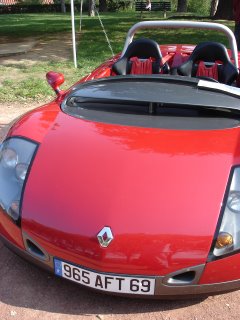
This Renault was about knee-high, with a retractable windscreen. French car designs are sometimes just plain strange. But you knew that.
 This beauty of an Audi convertible was one of my favorites--I'd never seen one in person before.
This beauty of an Audi convertible was one of my favorites--I'd never seen one in person before.Strictly speaking, it's an Auto Union 1000SP, from right before when VW bought Auto Union and started using the Audi name.

Dig the subtle tailfins, mirrored (literally) in the swell of the bumper. Sexy but not overdone. Who says the Germans are cold, calculating engineers?
I saved the best for last, though. This lemon-yellow beauty is a Citroen Mehari, built by Citroen on the 2CV chassis, originally for the French Foreign Legion and then for sale to the general public.
The body panels, bolted directly to the steel frame, are made of plastic. Thump them, go ahead. Thwock! Molded in color, so if you scratch it up, just break out the fine-grit sandpaper. That plastic body makes it nice and light, so the
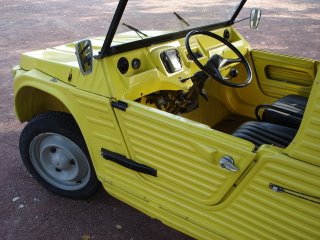 600cc 29-hoursepower motor gives you just loads of raw whining power for roaring around at speeds of up to, uh, I dunno, maybe 50-60 on a long downhill straight.
600cc 29-hoursepower motor gives you just loads of raw whining power for roaring around at speeds of up to, uh, I dunno, maybe 50-60 on a long downhill straight.Ragtop? Check.
Four-wheel-drive? Check.
Removable doors? Check.
Space in back for a couple of kegs on ice? Check.
Handy bins for storing your kepi and your Gauloises? Check and check.
That French je ne sais quoi? Mais oui!
And, and! They used one in The Muppet Movie.
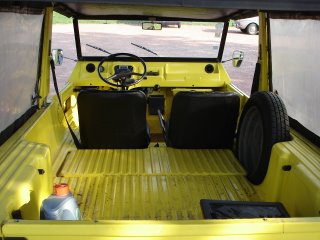 If that's not street cred I don't know what is.
If that's not street cred I don't know what is.Boy, it's a good thing I didn't have my checkbook on me, or I would have written the guy a check right there. Look, hon, I bought us a new car! No, no, forget about the Beemer. Look how cool this is! What? Air bags, schmair bags--it doesn't even need seat belts. And look! Thwock thwock thwock.
If I can find one of these in decent running condition under a couple grand (and can figure out how to get it to the States) I am so buying it.


4 Comments:
At 6:59 PM, Anonymous said…
Anonymous said…
I especially enjoyed this one. Glad to see that the French rightly honor the Muppetmobile!
At 4:52 PM, Anonymous said…
Anonymous said…
Yodaddy is going to be sorry he missed this one. May have to come back.
At 3:37 PM, Anonymous said…
Anonymous said…
Hispano Suiza was a spanish brand, and his chief designer was swiss, okay, but probably, the deGaulle's car was a french-built unit. Due to diverse circumstances, Hispano-Suiza built a factory in France, where most of the H6 and J12 types were built. After the WWII, french government took over full capital of the french factory, ad today makes aircraft parts as part of the snecma group. The spanish motherhouse, suffered expropiation of its main factory by the spanish government -then in hands of fascist dictator Francisco Franco-; new factory wasn't enough for continuing the business of making cars (and trucks, of course; last product of Hispano after war was a modern type of truck, that became the first Pegaso type after expropiation of La Sagrera factory); they tried to make a new middle-class car, but it wasn't possible and only few prototypes were built. Later, they made machine-tools, small trikes, electrodomestichs, pots, and Villiers 2-stroke engines. Now, the society is in an hibernation state, with no activity at all
At 8:34 AM, Unknown said…
Unknown said…
zzzzz2018.6.15
louboutin outlet
ecco outlet
kate spade outlet online
pandora charms
ed hardy clothing
adidas superstars
salomom shoes
canada goose jackets
coach outlet
jordan 8
Post a Comment
<< Home